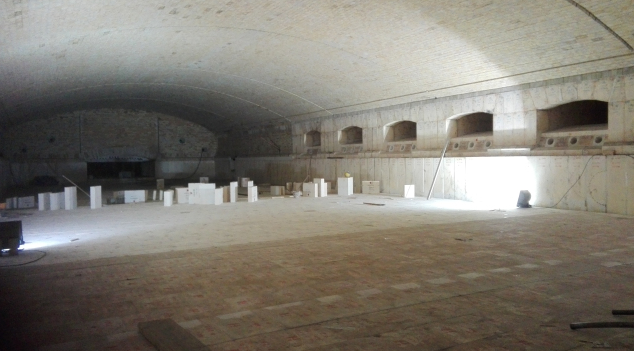

With the rapid development of the kiln industry, in recent years, leakage incidents often occur at the bottom of the furnace in some glass factories. According to the analysis of experts in Baisheng glass kiln engineering, the main reason for leakage is that the bottom structure can not effectively prevent the molten glass from drilling upward and the metal particles from drilling downward. Therefore, it is required that the bottom structure has the performance of preventing the molten glass from drilling upward and the metal particles from drilling downward.
Two types of erosion, that is, the glass liquid drilling upward from the bottom of the brick and the metal particles drilling downward, are caused by the convection of the free interface layer at the interface of three substances, which are usually refractory bricks-glass liquid bubbles or refractory bricks-glass liquid-metal. The result of convection in the interface layer intensifies the exchange of substances on the interface of three substances and the erosion of refractories. As we all know, the erosion of refractory bricks located at the glass liquid level is very serious, which is caused by this situation.
The glass liquid itself is rich in silica, which is acidic. When the kiln lining data touches the glass liquid, or under the effect of gas and liquid phase, powder and dust are scattered, it is severely corroded by chemistry. Especially at the bottom and wall of the pool, it is corroded by molten glass for a long time, and the chemical corrosion is more severe. The joint between the sealing layer under the paving brick and the embedded paving brick makes the fused brick, joint and sealing layer sinter at 1250℃ into a complete composite layer with resistance to molten glass erosion.
In the regenerator, the conditions such as high flue gas temperature and more dust are very strict. The initial erosion point caused by bubbles is in the horizontal joint between layers, such as the horizontal joint between the paving brick and the sealing layer when the paving brick is single-layer. There is less erosion in vertical joints than in horizontal joints. However, because the glass liquid flows into the horizontal joint through the vertical joint, the bottom paving brick, joint and sealing layer should be combined into a closed and inseparable whole to effectively prevent the glass liquid from seeping into the horizontal joint.
Three kinds of fused AZS ramming materials, which are basically the same as the crystal phase of paving bricks, are used as the sealing layer under paving bricks and the brick joints between paving bricks are embedded, so that the fused bricks, joints and sealing layer are sintered at 1250℃ to form a complete composite layer with resistance to molten glass erosion.
